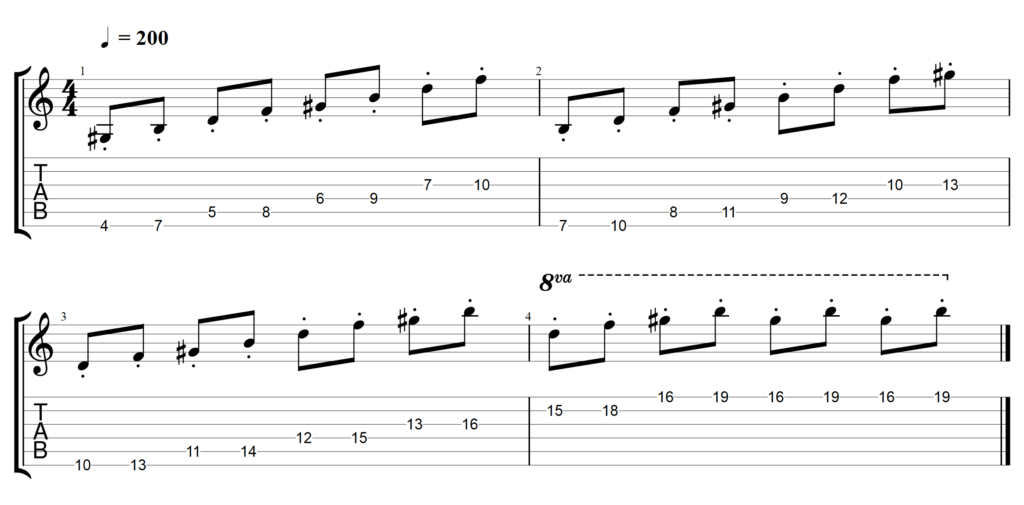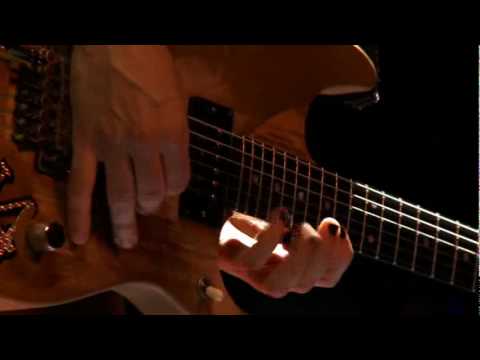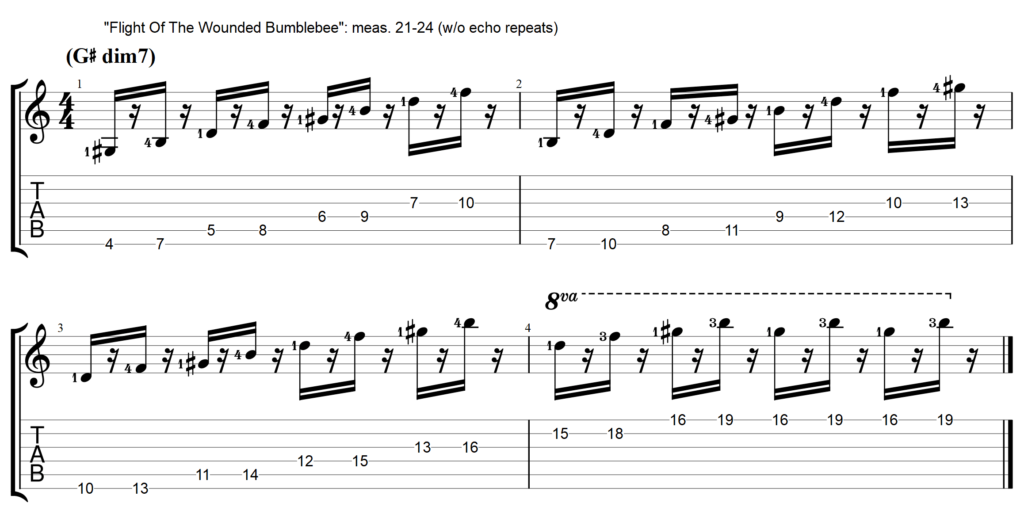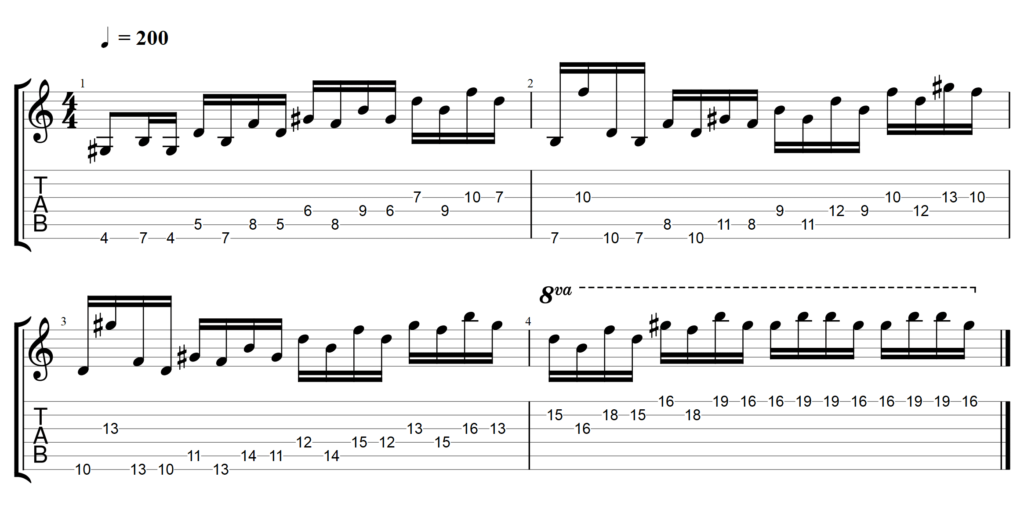Video length: 1 minute 32 seconds
Artist website: www.facebook.com/nunorocks
Musicians
Nuno Bettencourt – electric guitar
What makes this video great and what can you learn from it?
- good example of a Rock-guitar showcase solo piece
- how a mix of different techniques and approaches can keep a piece interesting despite the obvious lack of rhythmic variety
- how to creatively use delay to make a piece seem more complex than it is
What can you learn from this article?
- some background on the original “Flight of the Bumblebee” by Rimsky-Korsakov and my thoughts (rant – to be more precise) about the overuse/abuse of certain Classical pieces
- how to set up your delay unit to do 50% of the work for you
- a breakdown of various approaches that Nuno used – e.g. chromaticism, implied cadences, single-string pedal note sequences, open-string pedal notes, alternating triads and many more
Bonus
- get links to online delay calculators
- download the sheet music/tab for Nuno’s piece to tackle the “Wounded Bumblebee” yourself
Key Moments in “Flight of the Wounded Bumblebee”
| technique/concept | video timestamp |
|---|---|
| Chromaticism | 0:07-0:11, 1:02-1:04 |
| Implied i-V cadence | 0:11-0:16, 0:21-0:26 |
| Diminished 7th arpeggio | 0:26-0:30 |
| Single-string pedal note sequence | 0:31-0:50 |
| Open-string pedal notes | 0:17-0:19, 0:53-0:55 |
| 16th-note tapping | 1:09-1:30 |
| I – bV alternating triads | 1:25-1:30 |

“Flight of the Bumblebee” by Russian composer Nikolai Rimsky-Korsakov (1844-1908) is one of the most abused Classical pieces. Just watch any TV talent show and rather sooner than later some contestant will blaze through this piece on violin, piano, guitar, kazoo, whatever – and the audience will “ooh” and “aah” because they have been conditioned to associate virtuosity with this piece.
Yes, there is a flurry of notes and it is rather fast – however that in itself does not make a piece difficult.
Don’t get me wrong, Korsakov’s “Bumblebee” is technically rather demanding – and a cool piece. Originally from the opera “The Tale of Tsar Saltan,” it has its time and place. It’s the obnoxious abuse of the piece that I’m ranting against. Disregarding phrasing and nuances while focusing on speed just to impress an audience.
Sidenote: this does not just happen with pieces that seem to focus on speed/technique . Pieces like Pachelbel’s “Canon” or Beethoven’s “Für Elise“ have been turned into cliches – ending as a sort of placeholder to convey a certain style/mood or elicit a predictable emotional response from an audience.
“The Flight of the Wounded Bumblebee” is an awesome spoof by Mr. Bettencourt. It shares a lot of commonalities with Rimsky-Korsakov’s original and due to the clever use of the delay effect adds a nice layer of irony on the whole theme of virtuosity in the context of a virtuosic Rock guitar solo.
But before I get too meta about irony or, alternatively, jump straight into the more detailed technical aspects of Nuno’s solo showcase, let’s first cover the (especially for this piece) essential delay effect in general.
The Delay Effect
A delay effect is one of the most commonly used effects for a guitarist. Many players use it to fatten up their lead sound. However, when you start to increase the value of the delay time parameter, you can also use it to add a more pronounced echo effect which allows you to play with/against yourself.
Set-up the Delay to Be in Time with Your Song
To get the best, most useful sound, set up your delay so that it repeats the notes as a subdivision related to the tempo of the song. This way, the additional notes (generated from the delay unit) are integrated into the song and the overall effect is more musical.
For his piece, Nuno sets the delay to a dotted 8th note value and a single repeat. So, any note he plays will be repeated once – a dotted 8th note later. The amount of repeats is usually determined by the feedback parameter of the delay unit.
With this configuration you only need to play solid 8th notes and the end result is a constant stream of uninterrupted 16th notes because the notes generated by the delay fall between the 8th notes you are playing. The delay does 50% of the work for you. Nothing wrong with that, right? After all, that’s what tools are here for. The “Wounded Bumblebee” therefore is actually way easier to play than it sounds. All thanks to the clever use of delay.
Two essentials to watch out for when playing with delay:
- don’t make mistakes, because the mistake will be repeated by the delay
- playing in time is even more important, otherwise the delay notes won’t be in time as well and the rhythm will suffer – worst case scenario: the repeated mistake (coming from the delay) might irritate you enough to make another mistake. Then the vicious cycle will continue.
But how do you know which settings to use?
Delay Calculators & the Science/Math For the Trick
Almost all modern delay units (hardware rack units, stomp boxes or VST plugins in the digital realm) have a mode that does the calculation for you. You simply either tap in the tempo or punch in the bpm settings, choose what subdivision you’d like to get and the delay unit does the rest.
If your device does not have that automatic option, you can still achieve the effect. It’s just more inconvenient and you’ll have to use a delay calculator or do the calculation yourself before changing the settings manually.
Here are a two links to online calculators. Both pretty much do the same thing. Simply choose the one that appeals to you most!
- https://app.soundgrail.com/delay-calculator/
- https://anotherproducer.com/online-tools-for-musicians/delay-reverb-time-calculator/
And finally, let’s do it the old-school way without an app. Here’s how it works …
Tempo is measured in bpm – which stands for beats per minute. So for instance, 120 bpm equals 120 beats per minute. If 120 beats take 60 seconds, we only have to divide 60 by 120 to get the time it takes for a single beat.
Formula:
60/tempo = length of 1 beat in seconds
Let’s stay with our 120 bpm example.
60 seconds/120 = 0.5 seconds = 500 ms. Now you know the duration of one beat at this tempo. An 8th note is half of that (250 ms), a 16th is a quarter of the 1-beat value (125 ms), an 8th note triplet is a third (166 ms) etc.
“Flight of the Wounded Bumblebee” is at the rather brisk tempo of 200 bpm. To get the value of 1 beat we have to divide 60 by 200. This gives us 0.3 which translates to 300 ms for a quarter note. An 8th note is half of that = 150 ms. A 16th note = 75 ms.
For our required dotted 8th note (8th note value + 16th note value) the equation is: 150 ms + 75 ms = 225 ms.
But enough of that rocket science math sorcery. The good news is that with the correct delay settings our “Flight Of The Wounded Bumblebee” is much more manageable now. It still has its challenges (to bring it up to speed, to play it cleanly, to memorize the patterns, to switch between the various playing techniques) – but again, it’s manageable.
No-Delay Note-for-Note Transcription
The crazy thing is, there was a note-for-note transcription by Dave Whitehill in the January 1991 issue of “Guitar School” magazine as if played without delay.
I bet there were a lot of people extremely frustrated because they couldn’t manage to learn the piece at the required tempo because it was so difficult. Including me. I’ll come back to this craziness with an example later on when we discuss the staple Neoclassical diminished 7th arpeggio.
Nuno himself confirmed the use of a delay in an interview/workshop. Here’s what he had to say:
“I saw Whitehill’s transcription. It was really on the money, but the thing is, I didn’t literally play every single note you hear. I used a digital delay for the part you are talking about. All I actually did is this (performs Figure 10), the delay fills in the rest.”
Nuno Bettencourt
January 1992 issue of “Guitar World” magazine, p. 66
So when you do want to add this solo piece to your repertoire feel free to use a delay. After all, that’s how Nuno did it, too. Now, let’s cover some of the specifics.
Chromaticism
“Chromos” is derived from the Greek χρῶμα which means color. Chromatic scale literally means “colored scale” – basically because all the available musical colors are used. Unlike a diatonic scale with its particular sequence of whole and half steps, the chromatic scale consists of half-steps only.
Nuno starts with a 2-note pattern which he shifts chromatically down fret by fret. It’s easy to see how all the notes within the octave are being used.
Later in the piece Nuno reverses the idea for a quick ascending run. Notice how the downwards 2-note motive moves up along the high E-string.
Chromaticism: 0:07-0:11, 1:02-1:04 – back to overview
Implied i-V Cadence Am – E
After the initial chromatic descent over the first couple of measures, Nuno settles into a pattern that can be interpreted as a sequence implying an Am – E chord progression. Occasionally, Nuno adds some tension by shifting the implied Am up a half-step. But in essence this whole section is all about that Classical i to V cadence.
Actually, this is a great example of how implied harmony is perceived. There is no band or other instrument providing chords (harmony) in the background. However, even though Nuno plays solo (that metronome-like time-keeping percussion loop doesn’t count), the listener still has the sense that the harmony changes.
That’s because there’s a clear emphasis on chord tones happening on strong beats that outline the harmonic change from Am (A note as root and the C note as the b3 of Am) to E (G# is the major 3rd and the B note is the 5th of E). It also helps that i-V is such a typical progression that everybody has been exposed to millions of times – to the point that it seems to be ingrained into our musical DNA.
Implied i-V cadence: 0:11-0:16, 0:21-0:26 – back to overview
Neoclassical Staple – the Diminished 7th Arpeggio
Take note of the really practical way of playing the diminished 7th arpeggio. A diminished 7th chord is symmetrical in structure, meaning all the notes are an equal distance away. Minor 3rds in case of the dim 7th chord.

Except the staccato notation looks somewhat friendlier.
Play the minor 3rd interval using your 1st and 4th finger and shift your position up 1 fret when switching to the next string. When the sequence starts again with the next inversion your 1st finger already is in the right position and you simply have to skip back to the low E-string, which makes visualization a lot easier.
Compare this rather straightforward way of ascending the arp with the finger-busting way of playing without a delay unit. Especially the string skipping and the many position shifts definitely are not that simple to get up to speed while retaining precision and clarity.
Diminished 7th arpeggio: 0:26-0:30 – back to overview
Wide-Stretch Single-String Pedal Note Sequence
The piece modulates into a major feel/tonality and Nuno utilizes yet another staple Neoclassical device: the pedal tone. Notice how in the first two measures of this example an “A” note gets played on the downbeat and on the off-beats the notes change.
The same principle applies for the next two measures – changing melody notes on the off-beats over a consistent lowest “G” note on the downbeats.
Followed by two measures of “F#” and two measures of “F” as pedal tone. This is extremely effective, especially with the delay effect.
If your hands are on the smaller side and/or you haven’t developed your stretches yet – take it easy. Don’t strain and force it. You don’t want to injure your hands. Give it enough time and consistent practice and you’ll be able to eventually handle the stretch of a minor 6th (fret 14 to fret 22) on a single string.
Single-string pedal note sequence: 0:31-0:50 – back to overview
Large Interval Jumps – Open E-String Used as Pedal Note
But we aren’t done with the pedal notes, yet. Here’s another clever use case. To help with the position shifts, Nuno uses the open high E-string as a pedal note. This makes jumping around the fretboard a lot easier because the open string provides the opportunity to make the position shift. You also get larger intervals, which open up the sound, and the recurring note functioning as a pedal point providing a sort of anchor base for the phrase.
File this open string use case in the back of your mind! It’s definitely a neat trick for many different scenarios and you’ll be amazed how often you’ll find it being used when analyzing solos of the greats.
Open-string pedal notes: 0:17-0:19, 0:53-0:55 – back to overview
16th-Note Tapping
Whenever one launches into a tapping part, it’s hard to NOT make it sound Van Halen-ish. One way to do it is to avoid the blatant standard triplet figure of tap – pull – hammer and play tap – pull – pull – hammer instead.
Additionally, the delay now also functions as a harmonizer. The notes generated by the delay don’t just fall between the notes, but on top of notes you play, and are thereby creating harmony.
16th-note tapping: 1:09-1:30 – back to overview
I – bV Alternating Triads
For the final run Nuno alternates between two triads a tritone (b5 interval) apart. This has a tension-building effect while at the same time it is rather easy to play. You can keep using the same triad shape and all you have to do to achieve that sinister tritone effect is to simply move up a fret when changing to the next higher string. Only when switching from the G to the B-string do you need to move the shape up an additional fret (2 in total) to compensate for that smaller intervallic distance between those strings due to the tuning of the guitar.
Switch off the delay and end on an open-position A5 power chord and the piece is done. Voilà.
I-bV alternating triads: 1:25-1:30 – back to overview
Conclusion
No Shame in Making Technology Work for You
- To help you learn the piece, download the transcription! Simply click the button below – no registration or jumping through hoops necessary.
- Learn the piece slowly without delay first, then add the effect. Just make sure to adjust the delay settings to your tempo.
- If you are brave (super-ambitious) and have a high threshold for frustration, get your hands on the note-for-note transcription (by Dave Whitehill – January 1991 issue of “Guitar School” magazine) and learn to play the piece as if played without delay.
- Finally, have fun and experiment with a delay effect – try 16th notes and/or dotted eighth note values for your own improvisations
(Note: Nuno tuned his guitar down to Eb tuning – this transcription is in standard tuning to keep things simple)
Just in case you are wondering why the key signature for the final chord shows A major instead of the expected A minor … A minor definitely would make sense and would bring the piece back full circle to the initial tonality. However, “Flight of the Wounded Bumblebee” is not “just” a piece in itself, it’s actually the intro to the next track on Extreme’s “Pornograffiti” album. The last-measure A5 power chord is in essence the start of “He-Man Woman Hater” – and that piece is in the key of A.
The following guitarists are known for their creative use of delay – I plan to add some of their delay examples over time to the site. Make sure to occasionally check the “delay” tag for updates!
Sources
Guitar School Magazine 1991/01
Guitar World Magazine 1992/01
Get notified whenever I publish a new article!
Absolutely NO Spam – Unsubscribe Anytime.

















